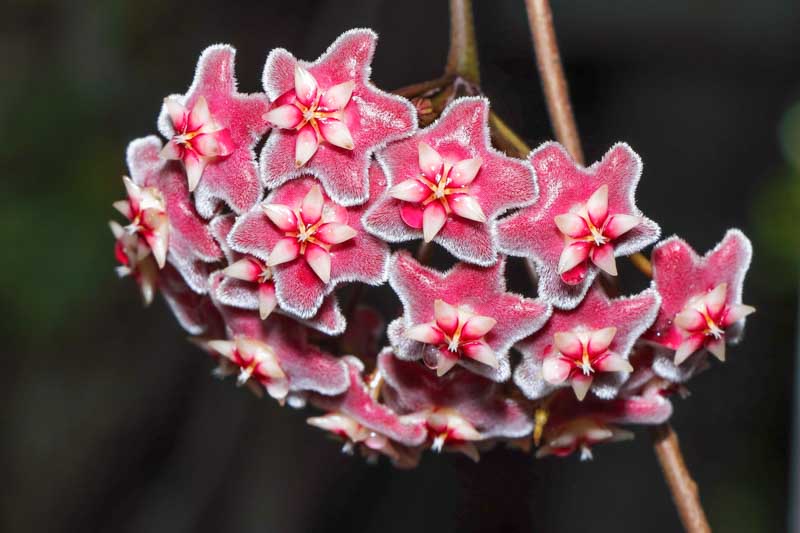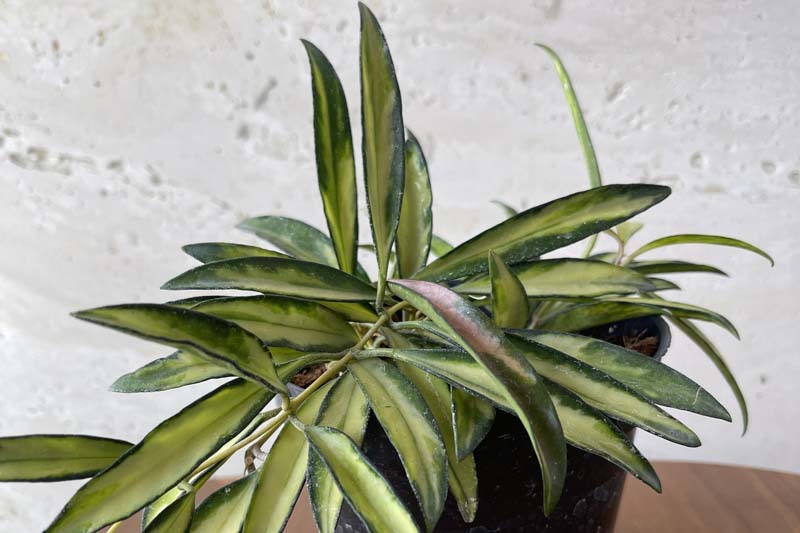Wax Plant
Hoya wayetii, a member of the Hoya family, is admired for its unique appearance and easy-care nature, making it a popular choice among houseplant enthusiasts.
Hoya wayetii is recognized for its elongated, lance-shaped leaves that are dark green with lighter green to creamy margins. The leaves are often slightly curved, creating an attractive cascading effect, especially when grown in hanging baskets.
Native: This species is native to the Philippines, where it thrives in tropical forest conditions, typically growing as an epiphyte on trees. Hoya belongs to the dogbane family (Apocynaceae), along with plumeria, periwinkle, mandevilla, or oleander.
Plant Type and Habit: Hoya wayetii is a tropical evergreen vine, perfect for hanging planters or as a trailing plant on shelves and ledges. It can also be trained to climb on trellises or support structures.
Size: When grown indoors, Hoya wayetii can reach 3-4 feet in length (90-120 cm), depending on the growing conditions and how much it is allowed to trail or climb.
Hoya Flower: The plant produces clusters of small, star-shaped, fragrant flowers that are red to burgundy with a central star that is often a lighter color. The flowers are waxy in appearance and can last for several days. Flowering typically occurs in the warmer months, with adequate light and care encouraging the plant to bloom repeatedly
Fruit: After successful pollination, it can produce small seed pods, though this is a rare occurrence in an indoor setting.
Foliage: The foliage of Hoya wayetii is its standout feature. Its climbing or trailing stems are clothed with pairs of thick, narrowly oval-shaped, waxy dark green leaves with a fine dark red edge.
Hardiness: It prefers warm, humid environments and is best suited for indoor cultivation in cooler climates. Outdoors, it can be grown in USDA hardiness zones 11-13.
Uses: Primarily grown for its ornamental value, Hoya wayetii enhances indoor spaces with its trailing vines and charming flowers. It’s suitable for living rooms, bedrooms, and offices where it can receive ample light.
Toxicity: Hoya wayetii is non-toxic to pets and humans, making it a safe addition to households with animals and children.
Invasiveness: It is not considered invasive, as it’s mostly grown in controlled indoor or greenhouse environments.
Benefits: In addition to its visual appeal, Hoya wayetii is believed to contribute to improved air quality by filtering out certain toxins from the environment.

Growing and caring for Hoya wayetii involves providing conditions similar to its native tropical environment.
Light: Hoya wayetii flourishes in bright, indirect sunlight. A spot near an east or west-facing window where the plant receives gentle morning or afternoon sun is ideal. Direct sunlight can scorch the leaves, while too little light may inhibit growth and flowering.
Soil: Use a well-draining potting mix. A blend of peat moss, perlite, and orchid bark works well for Hoyas, providing the aeration and drainage the roots need.
Water: Water when the top inch of the soil feels dry to the touch. Hoya wayetii prefers to be slightly dry between waterings. Overwatering can lead to root rot, so ensure your pot has good drainage.
Temperature and Humidity: Maintain indoor temperatures between 60-85°F (15-29°C). Hoya wayetii is sensitive to cold and should be protected from drafts and sudden temperature drops. s a tropical plant, Hoya wayetii appreciates higher humidity levels. A humidifier, pebble tray, or regular misting can help meet its humidity needs, especially during dry winter months.
Fertilization: Feed your Hoya wayetii with a balanced, water-soluble fertilizer diluted to half strength every 4-6 weeks during the growing season (spring and summer). Reduce feeding in fall and winter when growth slows down.
Pruning: Pruning is generally not necessary, but you can trim the plant to shape it or control its size. Avoid removing the long tendrils where flowers develop, as Hoyas will rebloom from the same spurs.
Repotting: Hoyas, including Hoya wayetii, prefer to be slightly root-bound. Repot every 2-3 years or when the plant has outgrown its pot, using the next size up pot with fresh, well-draining potting mix.

Propagating Hoya wayetii is a rewarding way to expand your collection or share this beautiful plant with others. Here’s how to propagate Hoya wayetii through stem cuttings, a simple and effective method:
Choose a Healthy Stem: Look for a healthy, vigorous stem on your Hoya wayetii that has at least 2-3 nodes (the points where leaves attach to the stem). Healthy stems are more likely to root successfully.
Cut the Stem: Using your clean, sharp scissors or pruning shears, cut the selected stem, ensuring each cutting is about 4-6 inches long. Make the cut just below a node.
Prepare the Cutting: Remove the leaves from the bottom node or two to prevent them from rotting when planted. This also exposes the nodes, where roots will form.
Apply Rooting Hormone (Optional): Dip the cut end of the stem into rooting hormone. This step is optional but can help encourage root development.
Plant the Cutting: Fill your small pot with the well-draining potting mix and make a hole in the center. Insert the cut end of the stem into the hole, ensuring at least one node (preferably two) is buried in the soil. Gently firm the soil around the stem.
Create Humidity: To create a humid environment around the cutting, you can cover the pot with a clear plastic bag or place it under a propagation dome. Make sure the leaves do not touch the plastic, as this could encourage rot.
Place in Bright, Indirect Light: Position the pot in a location that receives bright, indirect sunlight. Avoid direct sun exposure, which can be too intense for the cutting.
Wait for Roots to Develop: Keep the soil lightly moist but not waterlogged. Roots typically begin to form within a few weeks to a few months. You can gently tug on the cutting to feel for resistance, indicating root growth.
Care for Your New Plant: Once the cutting has established a robust root system, you can care for it as you would a mature Hoya wayetii. Continue providing bright, indirect light, moderate watering, and occasional fertilization during the growing season.
Hoya wayetii is generally resilient, but like all plants, it may encounter pests and diseases.
Mealybugs: Look for white, cottony masses on stems and undersides of leaves. Remove with alcohol-dipped cotton swabs or apply insecticidal soap.
Scale insects: Hard, dome-shaped pests that attach firmly to stems and leaves, feeding on sap. Their presence can lead to yellowing leaves, stunted growth, and a decline in plant health.
Aphids: These small, green pests suck sap from new growth. Rinse them off with water or treat the plant with neem oil.
Whiteflies: They are tiny, winged insects that feed on plant sap, causing yellowing and weakening of leaves. Combat them by rinsing plants with water, using yellow sticky traps to catch adults, or applying insecticidal soap or neem oil to affected areas.
Root rot: Caused by overwatering and poor drainage. Ensure well-draining soil and allow the topsoil to dry out between waterings.
Leaf Yellowing or Drop: Overwatering is a common cause of yellowing leaves, while underwatering might lead to leaf drop. Both are signs of stress due to improper watering practices. Ensure the plant is in well-draining soil and allow the top inch of soil to dry out before watering again. Adjust watering frequency based on the season and the plant’s growth phase.
Leggy Growth: This occurs when the plant is not receiving enough light, causing it to stretch towards the nearest light source. Increase the amount of indirect light the plant receives. Pruning leggy stems can also promote fuller growth.
Lack of Flowering: Insufficient light is the most common reason Hoya wayetii may not bloom. These plants thrive in bright, indirect light. Move your plant to a brighter location, but avoid direct sunlight, which can scorch the leaves. Providing a few hours of morning sun can encourage blooming.
| Hardiness |
11 - 13 |
|---|---|
| Plant Type | Houseplants, Climbers |
| Plant Family | Apocynaceae |
| Genus | Hoya |
| Exposure | Partial Sun |
| Season of Interest |
Spring (Early, Mid, Late) Summer (Early, Mid, Late) Fall Winter |
| Height |
3' - 4' (90cm - 120cm) |
| Maintenance | Low |
| Water Needs | Average |
| Soil Type | Loam, Sand |
| Soil pH | Acid, Alkaline, Neutral |
| Soil Drainage | Well-Drained |
| Characteristics | Showy, Evergreen |
| Garden Uses | Hanging Baskets, Patio And Containers |
| Garden Styles | Mediterranean Garden |
| Hardiness |
11 - 13 |
|---|---|
| Plant Type | Houseplants, Climbers |
| Plant Family | Apocynaceae |
| Genus | Hoya |
| Exposure | Partial Sun |
| Season of Interest |
Spring (Early, Mid, Late) Summer (Early, Mid, Late) Fall Winter |
| Height |
3' - 4' (90cm - 120cm) |
| Maintenance | Low |
| Water Needs | Average |
| Soil Type | Loam, Sand |
| Soil pH | Acid, Alkaline, Neutral |
| Soil Drainage | Well-Drained |
| Characteristics | Showy, Evergreen |
| Garden Uses | Hanging Baskets, Patio And Containers |
| Garden Styles | Mediterranean Garden |
How many Hoya wayetii (Wax Plant) do I need for my garden?
| Plant | Quantity | |
|---|---|---|
| Hoya wayetii (Wax Plant) | N/A | Buy Plants |
Create a membership account to save your garden designs and to view them on any device.
Becoming a contributing member of Gardenia is easy and can be done in just a few minutes. If you provide us with your name, email address and the payment of a modest $25 annual membership fee, you will become a full member, enabling you to design and save up to 25 of your garden design ideas.
Join now and start creating your dream garden!
Create a membership account to save your garden designs and to view them on any device.
Becoming a contributing member of Gardenia is easy and can be done in just a few minutes. If you provide us with your name, email address and the payment of a modest $25 annual membership fee, you will become a full member, enabling you to design and save up to 25 of your garden design ideas.
Join now and start creating your dream garden!